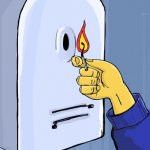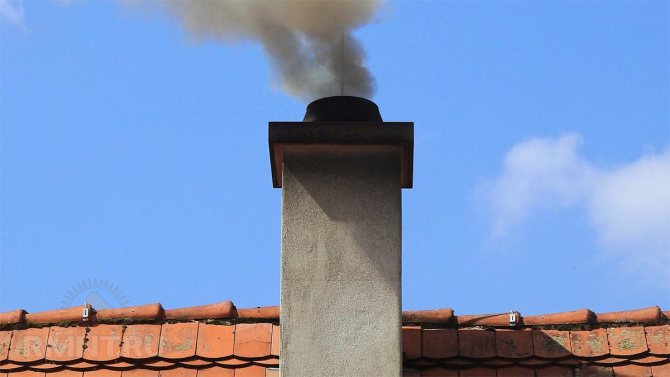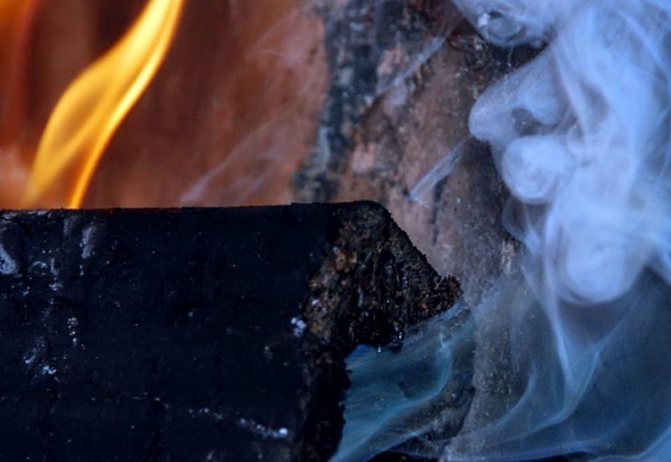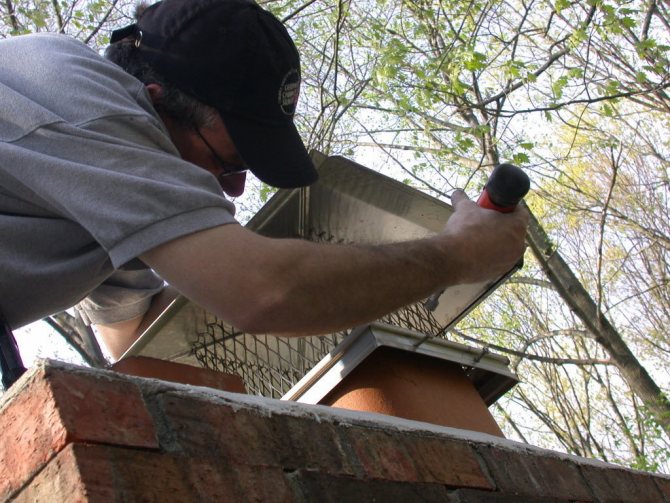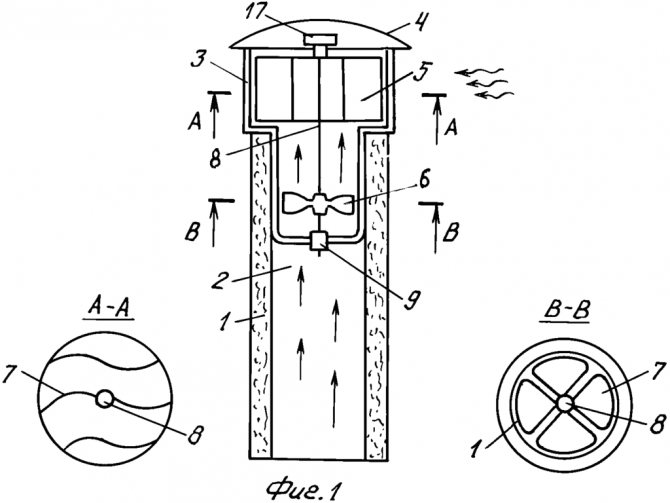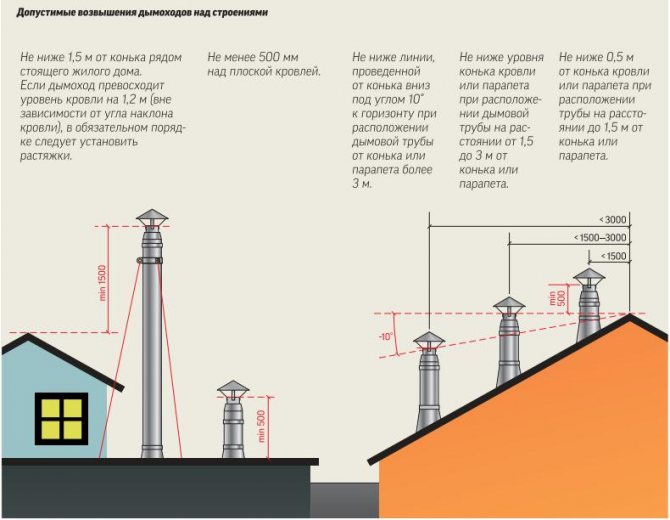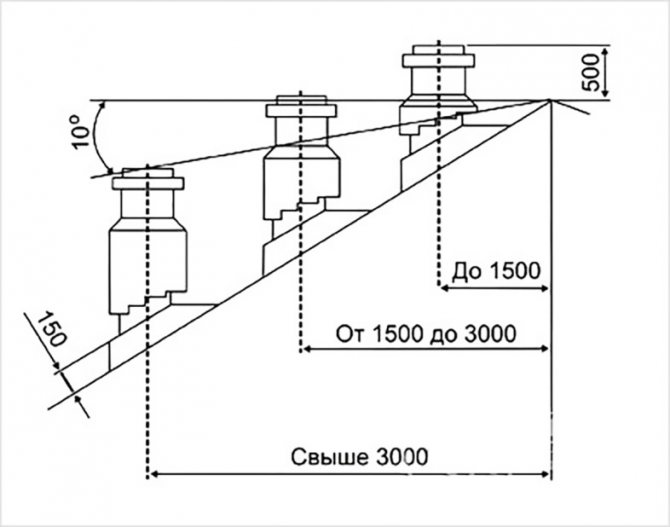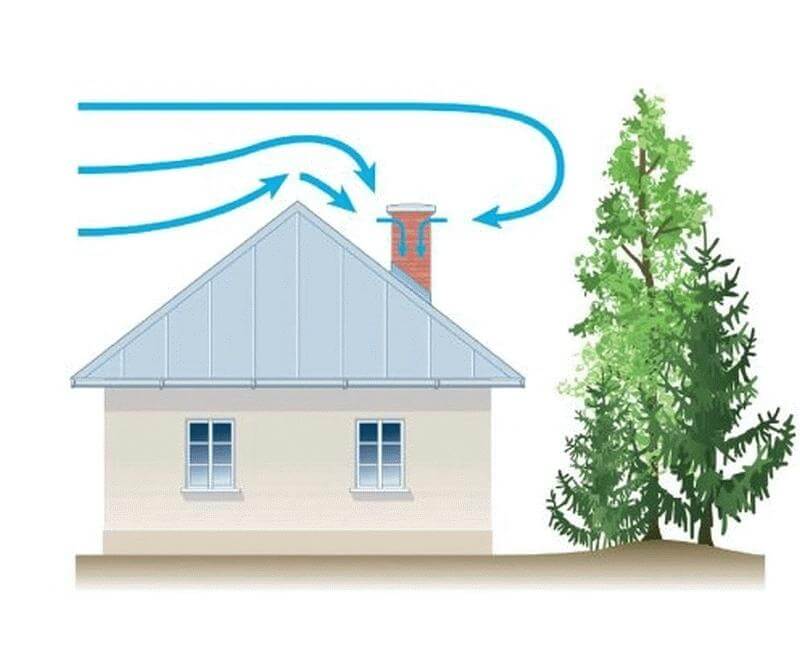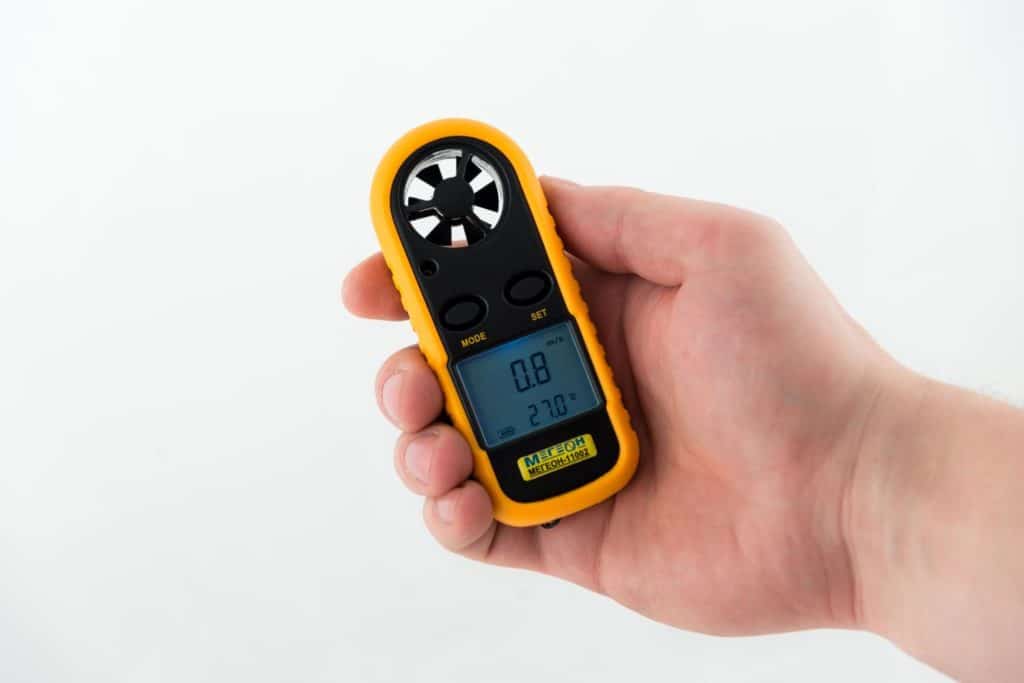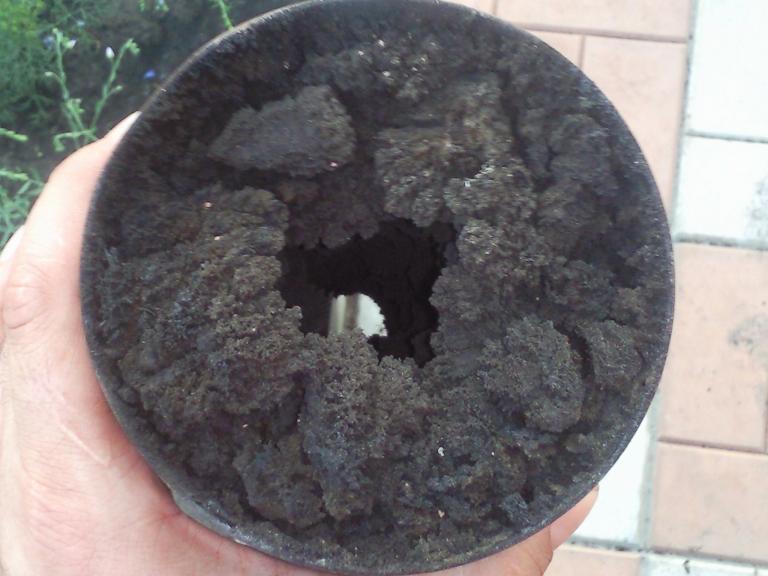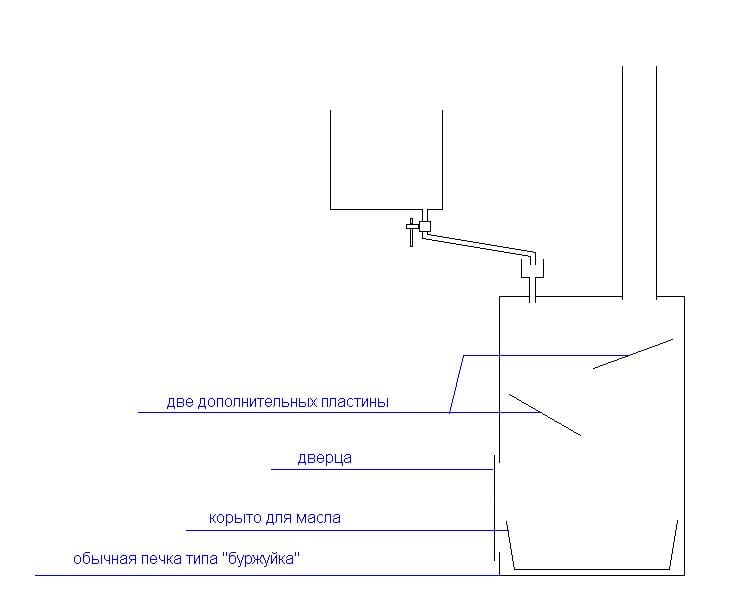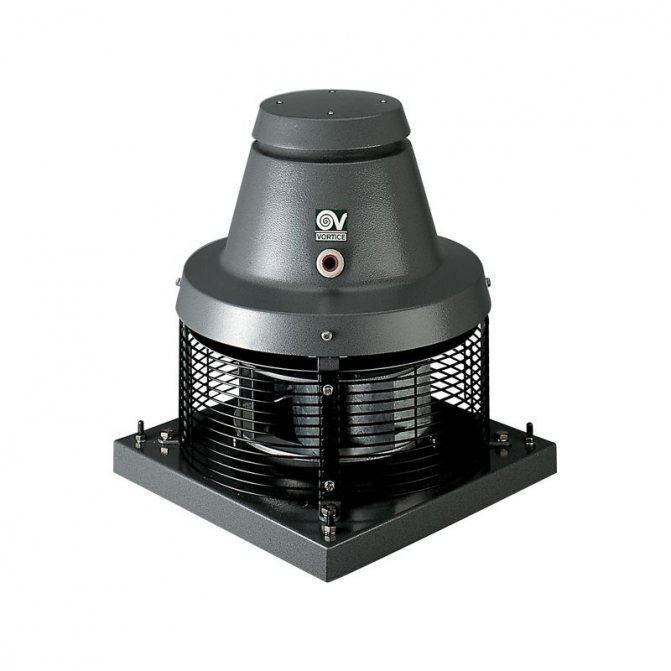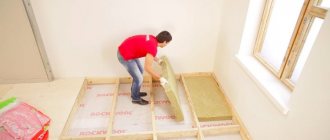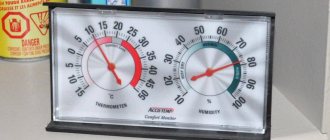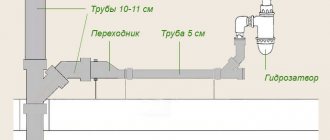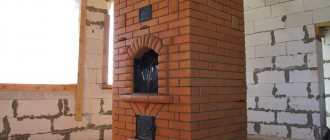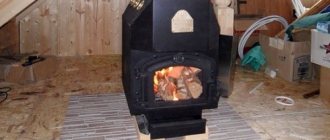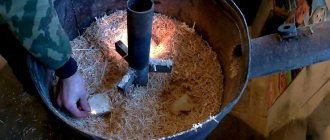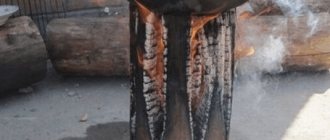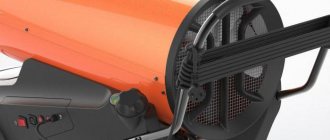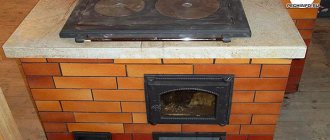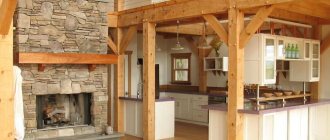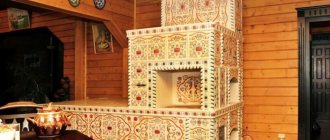- 1 What to do if smoke is detected?
- 2 How is the stove chimney checked?
- 3 How is the chimney cleaned?
- 4 Generation of smoke due to incorrectly dimensioned chimney
- 5 What needs to be done if smoke occurs when a potbelly stove is kindled?
- 6 What other causes of smoke can be identified?
- 7 What preventive measures can be applied?
To heat a house or other buildings, a traditional wood-burning stove is very often used. It is notable for its low cost, compact size, high efficiency, low cost of use and other positive parameters. Often, people are completely engaged in its creation and installation on their own, since there are no special problems with this.
However, during the operation of the stove, it is quite often necessary to face the fact that when the door is opened into the firebox, an unpleasant and rather strong smoke appears. It can also come from other structural elements of the stove. What are the reasons for this situation, what needs to be done to get rid of smoke, as well as what preventive work is recommended to be carried out, so that such problems do not arise in the future? About this in our article.
Furnace design problems
If the stove still smokes even when the fire door is open, you should think about the competence of the stove-maker who put it down. The most common mistake inexperienced craftsmen make is not broad enough
... Its dimensions depend, in particular, on the power of the heating unit. For example, for a stove with a capacity of 3.5 to 5.2 kW, the chimney diameter must be at least 189 mm, and the cross-sectional area (if rectangular) must be at least 0.028 m². Otherwise, carbon monoxide gases will tend to go outside not only through the pipe, but also through the firebox.
Trouble-shooting
The presence or absence of traction is immediately checked. Light a match and bring it to the boiler control window. If the flame deviates to the side - there is a thrust, it burns evenly - no.
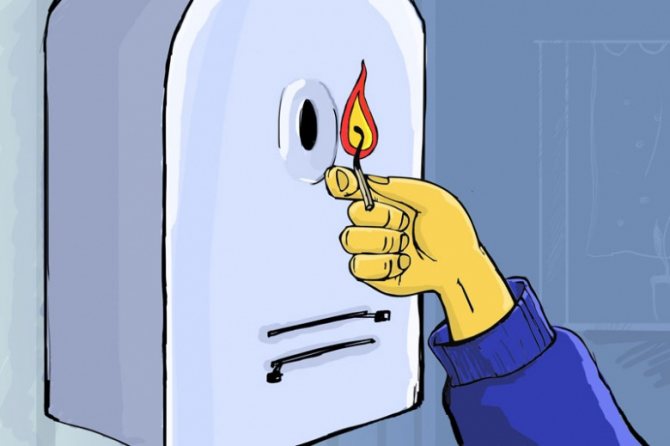
To understand what is causing the problem, look through the vent hole with a mirror and flashlight. So you can check for blockages, snow accumulation. For your part, you can clear the mine. And for cleaning from the street, it is better to contact a specialist.
See which flue pipe fits your model. Install the product with the correct diameter. Then carbon monoxide will be efficiently removed. The length of the pipe must comply with the regulations, and be higher than the ridge of the roof.
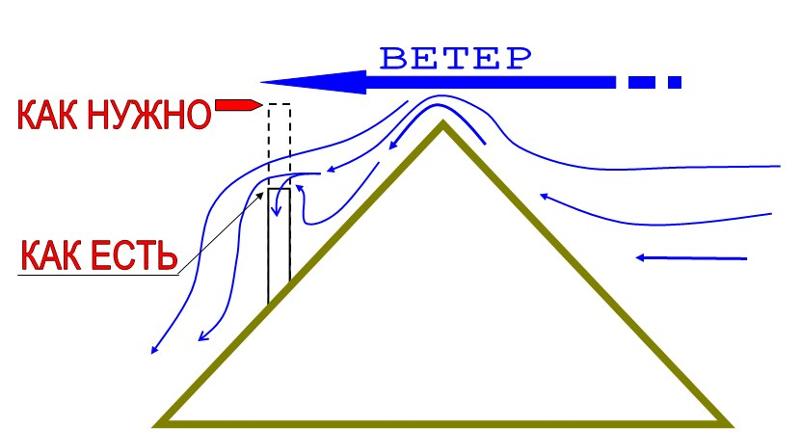

To prevent ice from freezing inside, insulate the mine. For self-design, use a sandwich construction. She already comes with insulation.
Inspect all connections for cracks, damage, inconsistencies. Press on the joints more tightly, use a special sealant to isolate cracks. In boiler rooms, open the window to create natural ventilation.
Follow our recommendations and you will be assured of uninterrupted operation of your gas equipment. Regular prevention of breakdowns is the key to efficient heating of your home.
The main causes of smoke
There may be several reasons why the smoke does not go into the chimney, but into the room:
- Raw wood is used. It is easy to solve this problem - you just need to take care of drying the wood in advance and store the fuel under a shed.
- The dimensions of the chimney and combustion chamber are incorrect. It is worth creating drawings based on the standard ratio: with a firebox measuring 70 by 70 cm, a chimney with a diameter of 110 mm is made.
If the potbelly stove smokes, the problem may be in the excessively large size of the ash pan.For the stove to work properly, it must be made 3 or more times smaller than the firebox.
- The chimney is not long enough. For high-quality implementation of traction, the outer pipe should rise 1.5-2 meters above the roof.
- The pipe is dirty. During operation, various substances accumulate in the chimney, which must be removed periodically.If there is an incorrect exit of smoke from the stove, not related to design features, it is necessary to check the chimney and take several preventive actions.
What needs to be done if smoke occurs when a potbelly stove is kindled?
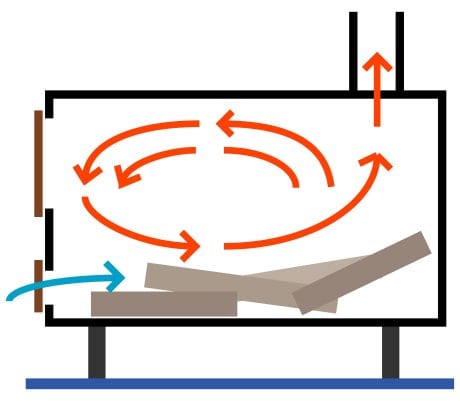

Also, very often it is necessary for the owner of garages or other small buildings that heat their buildings with wood-burning stoves, to face the fact that in the cold season during kindling there is a strong smoke in the premises.
The fact is that in a garage or in other similar structures, stoves are not used constantly, but with a certain frequency. A cold air blockage appears in the chimney in winter, which disrupts normal and optimal traction.
To fix this problem, you can use the following methods:
- a burning candle or torch is brought to the smoke collector, which eliminates the column of cold air;
- enough is burned near the smoke box a lot of paper.
Due to the above methods, the chimney heats up well, and the cold air comes out, therefore, if you do all the work correctly, you can get rid of the smoke from the stove.
Pulls, but not there
If the stove has not been used for a long time, the effect of "reverse draft" may occur - the cold air lock accumulated in the chimney does not allow the warm stream to pass through, and the smoke enters the room. What to do? Increase the temperature in the pipe! To do this, open the flaps before adding fuel - and throw burning paper through the cleaning door.
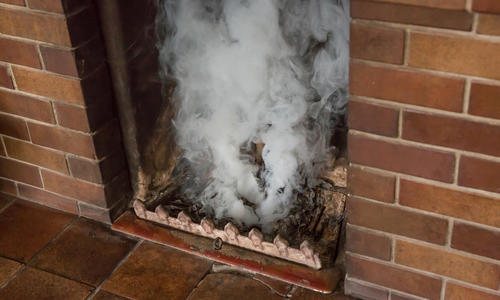

The chimney will warm up, the heated air will go up, and the draft will be restored. If this does not happen, the operation must be repeated again. But now the paper must be thrown directly into the pipe directly from the roof. After the fire goes out, light a piece of wood in the firebox and see where the smoke goes.
We suggest that you familiarize yourself with: The better to paint the bath inside
If you go outside, then you can lay firewood. A special nozzle - a deflector - will help to exclude the appearance of a backflow. This is a cylindrical metal product that is installed on the chimney from above. Due to its design, the attachment creates a low pressure area, increasing thrust.
Incorrect laying of a stove or well
Adequate chimney clearance is an important condition for good flue gas extraction. The pipe must be at least 15 cm in diameter (for a sauna stove - 10 cm).
During masonry, the stove-maker rubs the inner surface of all wells and pipes with a damp cloth. Whenever possible, all sharp internal corners are scraped off, turns are smoothed out. This creates a smooth inner surface along which smoke can easily move upward. This is done as the oven is laid.
Any turn, an additional well - this is another obstacle in the path of smoke. Therefore, the length of the pipe and its location on the roof must be adequately calculated for the design of a particular stove.
It is also important that the entrance to the first well (inside the firebox) is not lower than the upper edge of the door. Otherwise, there is a possibility that with each opening of the fuel chamber, smoke will go into the room.
Stove-maker's flaws are expensive. It is possible to fix something in the design only by shifting part of the furnace, or maybe by a complete restructuring.
A tall straight pipe with a smooth inner surface can be a salvation if minor miscalculations are made and the draft is weak:
- When located close to the ridge, the pipe should be at least 50 cm higher than it.
- When located 1.5 - 3 m from the ridge, the height of the pipe is allowed flush with the ridge and higher.
- The pipe can only be slightly lower than the ridge if it is located more than 3 m from it.
- The chimney height of 5 m or more is capable of providing full draft.
- In no case should the chimney be assembled from elements of different cross-sections!
It is advisable to make a pipe with a circular cross section. Unnecessary turbulence is created in the corners of rectangular smoke extractors, and soot is more readily formed.
Metal pipes "suffer" from a deterioration in traction more often than brick and asbestos pipes. This happens because the metal heats up quickly, it also quickly cools down on a frosty day. Warming with non-combustible material saves the situation.
How to check the chimney
If it smokes smoke in a room from a potbelly stove, the check begins with this element:
- The presence of foreign objects is checked. Often, the simple presence of objects blocking the chimney prevents normal functioning.
There are special soot cleaners
- The presence of soot on the walls of the chimney is determined. The formation of this substance has an extremely negative effect on the traction force. The reason may be the wrong construction of the chimney or irregular cleaning.
The appearance of soot after long-term operation without cleaning or the use of low-quality fuel can be the answer to the question of why the potbelly stove smokes through the door.
We recommend that you also study on this topic:
Brick smokehouse device: design and construction schemes
Having decided to equip a corner in the country where you can cook aromatic food, it is not necessary to purchase small smokehouses presented in specialized stores. You can build a smokehouse with your own hands from bricks - a reliable structure that can also become a garden decoration. Drawings and simple step-by-step instructions for performing work will help you create a model on your own.
Violation of the technology of stove masonry
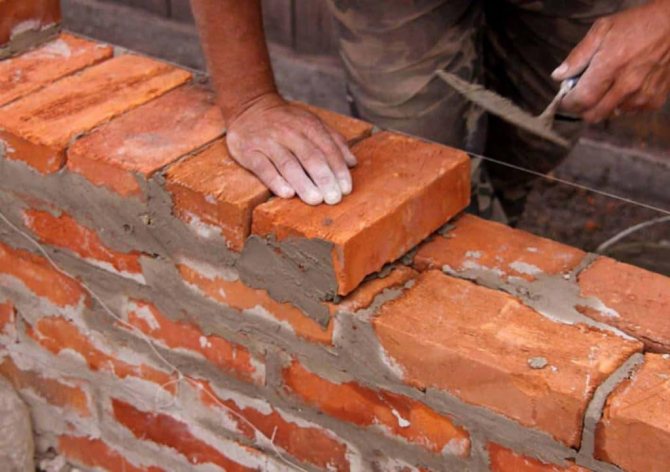

Violation of the oven stacking technology
If a new stove smokes, most likely any technological norms and standards were violated during its laying. Perhaps too narrow chimney openings were created or the design of the furnace wells was broken. Unfortunately, it is not possible to get rid of this with your own hands. The oven will have to be repositioned again.
This reason, perhaps, can be attributed to violations of the technology of the masonry of the stove. It differs from ordinary smoke in that it is characterized by the appearance of smoke precisely when the door is open. This can be explained by the improper design of the wells, in which the traction flows disrupt their natural course. That is, when the door is closed, there is enough draft to bring the smoke out, and when it is opened, its strength decreases, allowing the stove to smoke into the house.
We offer you to familiarize yourself with: Do-it-yourself repair of an old stove: technology, manuals, options
The elimination of this problem should be dealt with by a specialist. Because, most likely, you will have to shift the wells in such a way that the level of the first one is higher than the opening of the furnace door.
Lights up, but not in the camera
It so happens that sparks suddenly start flying out of the firebox, and after them streams of smoke appear. This usually happens when the combustion process moves from the combustion chamber to the flue duct. Most often, this disadvantage is eliminated when adjusting the traction. But sometimes, even with strong air currents, the stove still continues to smoke and spark. Try to put less wood in the firebox: check experimentally how much fuel will be optimal for the normal operation of the stove.
How to clean a pipe
If, due to contamination, the stove smokes when you open the firebox door, you can do one of the following:
- Perform mechanical cleaning.If the soot layer exceeds 2 mm, and there is windless weather without precipitation outside, you can work with a scraper, and then clean the pipe with a brush with gentle movements. If the blockage is not removed in this way, a cannonball tied to the cable should be used and thrown into the hole in the pipe.
- To resort to chemical compositions in the form of powders, liquids or briquettes. Suitable if there is a plaque of no more than 2 mm.
- Use special equipment. It creates a strong pressure of water that will knock down all foreign objects and remove plaque.
We advise you to read what to do if the boiler blows out through the chimney on our portal.
The weight is also used to determine where a blockage has formed in the pipe, which affects the smoking of the stove.
The following publications will perfectly complement this material:
Reason 1 - reverse thrust
To determine further measures to eliminate smoke from the stove, it is necessary to check the quality of the draft in the chimney system. The check is carried out in one of the following ways:
- Using an anemometer. High-precision professional device for determining smoke draft.
- Ignition of flammable material. The burning material is brought to the chimney grate - with good draft, the flame is directed upwards, with poor draft or its absence - it remains motionless.
- Visual check. If, when firing up the stove, the flame acquires a dark red tint, this indicates a decrease in draft. Good traction provides a light, almost white flame.
- The presence of a strong smoke smell. If pungent odors appear when the firebox is open, this indicates a mechanical clogging of the chimney system.
The complete list of reasons why a heating stove starts to smoke is quite large. In each individual situation, it is necessary to take into account: the nature (temporary or permanent) and duration of the smoke, the temperature regime inside the premises, weather conditions, design features and the service life of the equipment.
Subject to the technology of arrangement and kindling of the furnace, the likelihood of smoke pollution of the structure is minimal. But if the problem is nevertheless detected, then timely diagnostics and troubleshooting will ensure a long service life of the heating equipment.
Stove fumes can be caused by the so-called draft overturning. It usually occurs after the stove has not been heated for several days. At the same time, the traction was excellent earlier. Such idle time leads to the fact that the air flow changes direction to the opposite and does not go out into the street, but enters the dwelling.
To eliminate the back draft in the chimney, it is necessary to promptly increase the air temperature in the chimney. This can be done in several ways:
- through the highest located chimney cleaning door;
- opening hogs in the attic;
- throwing lighted paper into the outlet of the pipe. This method is used if the first two did not bring results. It should lead to the restoration of traction.
When the normal draft can be restored, it is maintained in the future with regular heating of the stove. Traction rollover should no longer be a concern. You can find one more - folk - the name of this phenomenon - "airlock". It is completely unfair to blame the stove-maker for its origin. It absolutely does not depend on its work, and the overturning of the draft can occur in any stove.
Preventive measures
It is necessary to clean from the formation of plaque not only the chimney pipe, but also other parts of the stove. Thus, attention should be paid to the following parts of the design:
- Layers of soot are also formed in the ash drawer, the blower and the space under the oven, due to which the potbelly stove can smoke.
- It will not be superfluous to check the structure for flaws and cracks that could have formed due to improper assembly of the furnace. Correcting these shortcomings will help to correctly direct the draft of the smoke.
- Sometimes the stove smokes because the door does not fit snugly enough. In this case, either the element is replaced, or the surface of the stove is leveled.
Only high-quality raw materials should be used as fuel and should not be replaced with sawdust and straw.
Cracks in the walls and in the chimney
Over time, a thick layer of soot settles on the inner walls of the furnace, and the masonry begins to crack under the influence of thermal loads. Taken together, all of this can also be the cause of smoke. You can try using aspen wood to remove soot. Their combustion is accompanied by a very high temperature, at which the deposits on the chimney are loosened and carried out together with the smoke.
However, this method is more effective as a preventive measure: if ash and soot have settled for many years, then aspen firewood is unlikely to help. Various chemicals in the form of special tablets, briquettes or pellets are also not a panacea. Best of all is mechanical cleaning. To do this, you will have to purchase tools - a core, a scraper and a ruff on a flexible cable.
Remember to open all flaps and close all doors before starting work. Having fixed on the roof, remove the cap from the pipe and remove the soot at a distance where your hand can reach. Then place a ruff in the chimney and, scrolling, gradually move it lower and lower. If you come across an obstacle that you can't break through, use the core.
Cracks must be repaired! Even a child can make the stove solution, which is necessary in order to cover them up. Mix well sifted sand and regular clay in a ratio of 2: 4, break up the lumps, and then splash in some water. The consistency should be like that of plasticine, so it is important not to overdo it with water.
Preparing the oven mortar When covering the slots, cover them with your hand on the back side if possible, otherwise the solution may end up inside the oven. Each time, before starting to work on the next crack, dampen it a little with water. After the mortar on the masonry has dried, see if its integrity has been compromised.
We invite you to familiarize yourself with: Roof drain pipes
Soot and kiln wear
Even if the stove was perfect during the construction phase, over time, the chimney opening can narrow due to the build-up of soot. This is an unavoidable process, which is why the oven is cleaned regularly. However, without wanting to, the owners can speed up the process of soot formation at times.
What mistakes should be avoided:
- Do not use raw wood, especially resinous wood.
- Do not abuse large amounts of synthetic waste (cellophane, plastic, rags, rubber ...) burning in the oven.
- During the construction phase, do everything possible so that the inner surface of the furnace does not have protrusions, is smooth and uniform.
- Do not try to turn a regular oven into a pyrolysis oven.
The latter is often sought to do by prudent owners, in order to save money. They restrict the air supply without opening the blower, but leaving only a small gap. The result is not burning, but burning and decay. But a Dutch woman or a Swede will never become pyrolysis, by their nature they should "hum" during the fire, and you can close the blower only when there are coals left.
Particular attention should be paid to the cleaning of the stove for those stoves that are regularly fired with coal. This fuel leads to a quick overgrowing of the pipe with soot (coal, like wood, needs to be given a sufficient amount of oxygen to give it a proper fire).
By the way, the fact that it is time to clean the stove can be suggested not only by the smoke in the house, but also by sparks flying out of the chimney into the street. This happens when the combustion does not take place in the furnace, but the soot itself burns in the wells.
If after cleaning, the traction problem persists or intensifies, it is possible that soot fell on some area during cleaning and the area was not cleaned. With an aged stove, such a nuisance can happen as the crumbling of a part of the brick, which is not noticeable from the outside.
To ensure the cleanliness of the wells along the entire length, additional holes can be made for cleaning. This is done using a hammer drill or a drill with a victorious drill.
How to make a chimney for a stove through the wall
If, during the search for the reason why the potbelly stove smokes when the door is opened, it was found that the problem is not in contamination, then the matter is in the wrong design.
You can make and install a chimney yourself. For a potbelly stove, a metal version is more suitable than a brick one. For these purposes, the most suitable will be alloy steel with a special coating that protects the surface from the effects of oxides. Just don't use aluminum pipe - it will melt.
During the manufacture, you will need the following elements:
- Metal pipes for the base of the chimney. A diameter of 16 cm is suitable.
- Docking knees. Their number will depend on how many times the direction of the pipe will be turned.
- Protective cap for the upper part of the chimney.
- Condensation pocket.
- Seam sealant.
- Pipe clamp.
- Thermal insulation.
Drawing for the manufacture of a chimney for a stove through the wall
After all the materials are ready, you can proceed with the installation:
- First of all, a through hole is made in the wall. Moreover, if the wall is wooden, a special metal box is installed with a hole in the center, which is 5 mm larger than the pipe diameter. For a brick wall, a pass-through glass is used.
The box is filled with basalt glass wool, and the hole is filled with asbestos strips.
- Next, the first section of the pipe is placed on the potbelly branch pipe. At the same time, the design is complemented by a heat-resistant seal and a special clamp that will prevent the breakthrough of gases.
- A knee is placed that leads the pipe towards the wall.
- After the pipe is brought out, a branch pipe and an elbow are placed.
Example of an external chimney pipe
- Insulation of the outer chimney pipe is in progress. To give stability, you can fix the structure with brackets.
- A protective cap is placed on the top of the pipe.
Having figured out how the chimney is installed through the wall, you can also pay attention to the options for the chimney through the window for the stove and through the roof.
Thus, having studied all the necessary instructions, you can take a number of actions to clean the finished pipe or create a new one. Such measures will help get rid of the smoke of the potbelly stove.
We recommend that you also study on this topic:
Potbelly stove on working off: pros and cons
Many motorists, with the onset of the cold season, a natural question arises - how to heat the garage, especially if it does not have a centralized heating system or the heating main runs far enough to be able to connect to it. In this case, the option of installing the oven will come to the rescue. Most often, for small rooms in which there is no permanent stay of people, for the purpose of heating, the most practical and inexpensive version of the furnace is used - a potbelly stove on waste oil products.
We recommend that you also study on this topic:
Do-it-yourself potbelly stove in the garage: options for wood and working off
In winter, it is very cold to be in the garage, so many motorists install homemade stoves in the room. These ovens quickly heat up the garage and can be used to cook food. Most often, garages install stoves on wood or waste oil.
Tags: door, smoke, iron, opening, stove, why
«Previous post
When the stove can smoke
Indoor smoke is always a deterioration or lack of draft.Incorrect flue gas movement is caused by several reasons.
With good traction, the fuel burns out completely, generating maximum heat. If it is bad, the stove smokes. There is not enough oxygen for combustion, volatile combustion products (smoke) are formed, which rush into areas with low pressure and high vacuum - into the room.
One of the main reasons for the smoke of new stoves is a violation of the smoke exhaust system. The pipes are installed in accordance with the following parameters:
- Chimney height - 500 mm above the highest point of the roof with a ridge distance of up to 150 cm.
- Chimney height = ridge height, if the distance between them is 150-300 cm.
- Not lower than 10º relative to the horizon of the ridge, at a distance of more than 300 cm from it.
- The minimum length of the smoke exhaust duct is 5 meters, counting from the stove.
- If the chimney is more than 120 cm above the level of the ridge, then it is strengthened with stretch marks.
If the oven is installed in a room with sealed plastic windows and
Without ventilation ducts, then the following happens:
- the heating device draws in combustion air from the room;
- over time, a lack of oxygen forms, a rarefaction occurs;
- air streams rush through the chimney;
- the stove goes out, the room is filled with smoke.
Many home owners install the hood only in frequently used functional areas - the kitchen and the bathroom. However, a separate channel is also equipped in other places where the movement of air masses is required: in a steam bath, a washing room, a boiler room.
It is a rare case when two heating devices are installed in a house with a common smoke exhaust channel without a dividing partition. When the smoke streams go towards each other, one of the stoves will smoke. To prevent air masses from colliding and creating turbulence, a junction box is installed under the pipe. With a partition, you don't have to heat the stoves in turn.
The mistake of the master stove-maker leads to a violation or weakening of traction, as a result of which the smoke enters the room. More often than others, there are three miscalculations:
- wrong section of the chimney: the diameter of the minimum pipe clearance for a bath is 100 mm, for a house - 150 mm;
- understated location of the inlet to the well relative to the edge of the door - smoke enters the room, one has only to open the stove;
- the use of elements of different sections and shapes when assembling the chimney - air turbulence occurs at the joints.
If the first three errors are eliminated by re-laying the stove by the master, then the gaps can be repaired yourself.
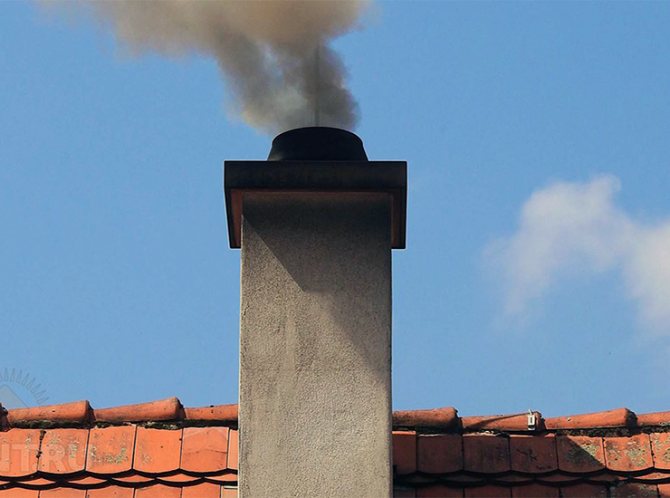

If the prevailing winds are determined during the construction of the building, chimneys are installed from the windward side. Otherwise, air vortices appear in the ridge, directed downward, blowing smoke into the chimney lumen. This can be avoided by observing SNiPs for the installation of chimneys. To compensate for gusts of wind without rebuilding the chimney, an anti-wind deflector is used.
We offer you to familiarize yourself with: Fireplace firebox (53 photos): projects of firebox for stoves, do-it-yourself firewood stand
There is a golden rule: before removing smoke, you need to decide at what moment the stove began to smoke. This will help identify the breakdown and quickly fix it. There are 3 options for when the stove can start to smoke.
When kindling
In winter, the stove most often begins to smoke when firing up, that is, immediately after lighting it up. This problem occurs with stoves that are used periodically. For example, the unit is in a country house or a bathhouse.
When opening the door
The old used stove is working properly, but the door was opened a little, and a column of smoke started to flow - most likely the temperature on the view is more than optimal. This often happens with iron stoves that are in the garage.
First you need to look into the firebox (the place where the firewood is laid) - it will be completely filled with white flame or yellow-red waves that go into the hailo.
With the wind
Under normal conditions, when everything is installed correctly, even a strong wind should not contribute to the smoke of the stove. If this happens, then the wind is blowing into the pipe. The effect is called "overturning or weakening of thrust".

